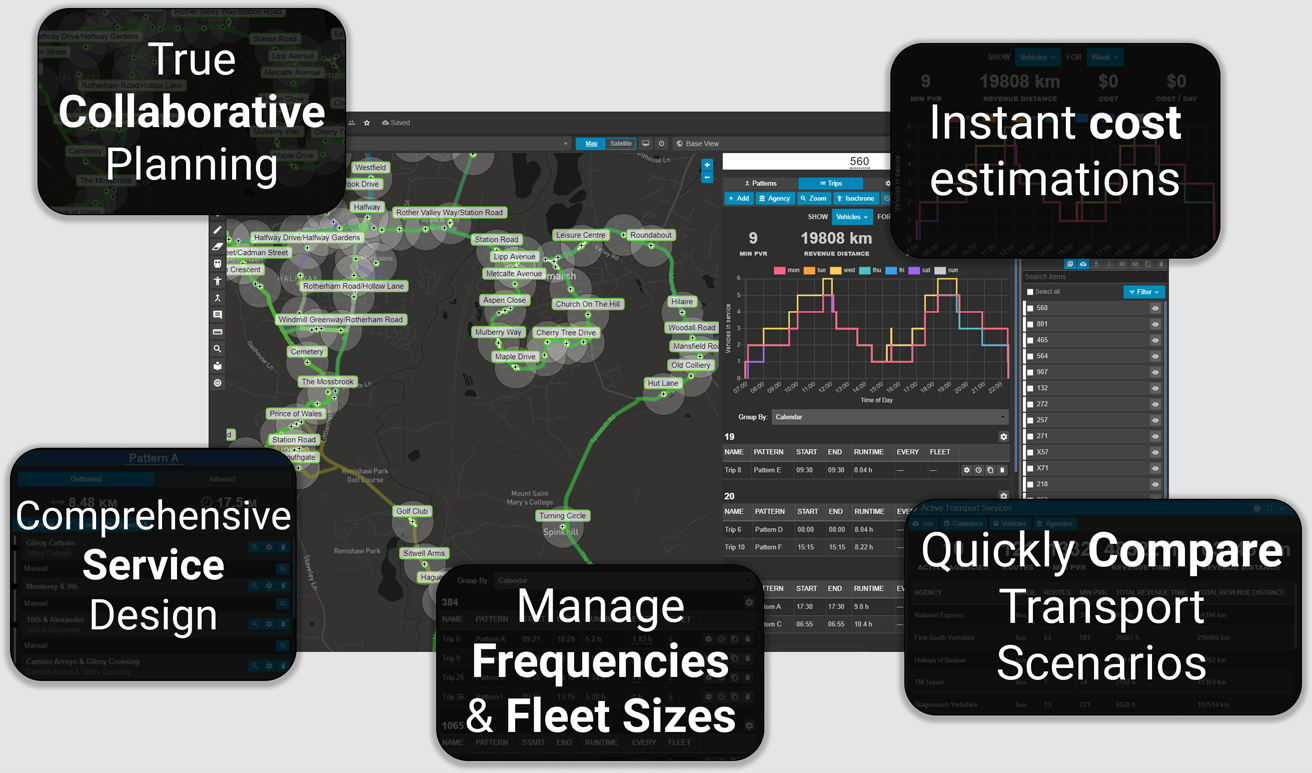This July, the DfT announced £226.5 million in recovery funding to maintain and improve bus services and support the aims of the UK's National Bus Strategy. In this article, we examine the importance of effective service planning and network design in fulfilling the NBS, and show how planners can design and explore routes in a fraction of the time taken by traditional methods.
The Podaris platform is a powerful yet easy-to-use multi-modal sandbox for the rapid development of transport scenarios. It helps Local Transport Authorities and operators evaluate the costs associated with alterations to routes, timetables and fleet sizes, and create services that support UK Bus Service Improvement Plans by identifying cost savings measures that can be passed onto passengers as cheaper fares.
Back in March, we looked at how flexible and easy estimating the cost of bus services is in Podaris. In this post, we're going to explore some of what goes into planning a bus route in Podaris.
The process of working with scheduled services can begin with the drawing of a new route, or the import of an existing transit feed. Importing a GTFS or TransXChange feed is trivial, and once uploaded, identifying busy corridors and making route alterations, such as merging overlapping routes, can be achieved in seconds with a couple of clicks.
It allows you to explore imported networks at-a-glance and understand if services in a region are “appropriately spread between corridors, avoiding significant over and under provision.” The National Bus Strategy identifies this as a key factor in making services more comprehensive - that is, reducing overprovision on a few corridors in order to improve provision elsewhere.
Outputs That You Can Trust

Getting started does not require importing a road network, and new routes can be created from scratch quickly and simply, while allowing you to retain complete control over your vehicle specifications, timetables, route layout and running costs. When creating new routes, Podaris takes care of finding the optimal path between the stops you add, vastly accelerating the design process.
As you create and amend your services, it automatically recalculates key metrics such as peak vehicle requirements, displaying them alongside graphs that help you explore capacity, fleet size and revenue distance. In line with the requirements of the UK's National Bus Strategy, these tools make it dramatically quicker to identify surplus vehicles on routes.
It's this ability to instantly evaluate changes to your routes by adjusting parameters such as headway and fleet size, that enable true agility in planning; helping you to explore the myriad possibilities associated with route optimisation, without the burdensome set-up time and complexity associated with more heavyweight tools. It helps you to meet the Bus Service Improvement Plan target of reactively optimising services in response to rapidly changing ridership.
As well as making BSIPs faster and easier to create, Podaris ensures that the policies detailed in your BSIP are informed by accurate data. We use built-in historical traffic speed data to guide accurate timetable generation, helping you to deliver on the strategy's condition that LTAs and operators provide more ‘frequent and reliable services’.
True Collaborative Planning
With Podaris, planning takes place in-browser, with all of your assets stored securely in the cloud. This means no setup time, no installation and the assurance of continuous backups. To further accelerate planning your BSIP, everything in Podaris can be done in parallel with the rest of your team, collaborating in real-time in a Google Docs style environment that allows your group to work on projects in unison. This eliminates the need to pass documents back and forth by email, providing a single source of truth for your projects.
Consider Podaris a remote office space for multi-disciplinary teams, all united on a single, secure company portal, where planning, comment sharing and even audio-video chat can be conducted without leaving the browser.
Of course, alongside planning, analysis is a crucial and powerful element of Podaris’ capabilities, and in upcoming articles we'll talk more about leveraging datasets and isochrone queries to perform demographic analysis and explore catchment along your routes, with a view to supporting the NBS in providing subsidised, equitable networks.
If you'd like to find out more about how Podaris can support you in developing Bus Service Improvement Plans, please schedule a demo now!